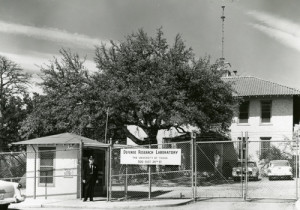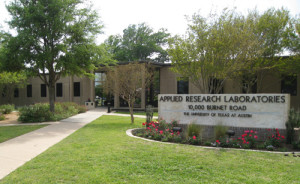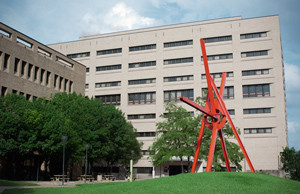Further information on the growth of acoustics during its early years at the University of Texas may be found by reading the In Memoriam resolutions for C. P. Boner, Lloyd A. Jeffress, Claude W. Horton, Sr., and Elmer L. Hixson.
Acoustics in the 1930s and 1940s

Defense Research Laboratory, established in 1945, later renamed Applied Research Laboratories.
Acoustics appeared as an academic field of interest at Texas as early as the 1930s. C. Paul Boner, Physics Department, studied auditoriums and sound studios, organ pipes, and other musical instruments, and Lloyd A. Jeffress, Psychology Department, began a long series of contributions on hearing. Boner and Jeffress were good friends. When the Physics faculty became depleted because of war work during World War II, Jeffress taught freshman physics. Boner, and several other Texas people, were recruited to work in the Harvard Underwater Sound Laboratory (HUSL); Boner served as Associate Director.
At the end of the war HUSL closed, and about a dozen of its personnel relocated to the University of Texas, including Boner, who resumed his faculty position in Physics, and Robert B. Watson, Claude W. Horton, and (a little later) A. Wilson Nolle, who became new faculty members in Physics.

Main entrance to Applied Research Laboratories.
In 1945 Boner established the Defense Research Laboratory (DRL) and staffed it with many who had been at HUSL during the war. Although DRL’s early focus was on radar and aeronautics, under the leadership of Richard N. Lane an underwater acoustics program was started. The first contract was on acoustical mine mechanisms. The underwater acoustics program grew rapidly, becoming the dominant part of the Laboratory by the late 1950s.
Located in some old buildings near the Texas Memorial Museum, DRL was the source of many jobs and research projects for students. It was funded entirely by the federal government, mainly Navy contracts. Although not part of any department, it maintained strong ties to Physics and Engineering. In 1967 DRL moved to Balcones Research Center (now Pickle Research Campus) and in 1968 changed its name to Applied Research Laboratories (ARL:UT).
Acoustics in Engineering

Department of Mechanical Engineering in the Engineering Teaching Center.
Except for Jeffress, acoustics at Texas before the war and just after was associated with physics. However, development of the underwater acoustics work at DRL began to bring Engineering into the picture. Frank W. McBee and Marcel Gres began working at DRL when they were Mechanical Engineering graduate students and also Instructors. Elmer L. Hixson joined the Laboratory in 1954 at the same time he became Assistant Professor in Electrical Engineering.
Although Physics faculty members Horton, Nolle, and Watson maintained an ongoing interest in acoustics, the Department’s growth was in other areas and interest in acoustics declined in the 1950s and 1960s. Engineering picked up the slack. About 1960 Hixson set up an acoustics laboratory in EE and began supervising graduate students; he started teaching a transducers course (EE) in 1962. The availability of DRL for support for graduate students prompted ME to look for a faculty person in acoustics. George J. Gruber, Assistant Professor in Mechanical Engineering (1965-71), was recruited in the Mechanical Systems area. Hixson and Gruber soon collaborated to set up and teach two new engineering acoustics courses (ME and EE), one at the graduate level and one at the undergraduate level; these were in addition to the transducers course. A boon to the new program was the large underwater pool, originally intended for use by DRL, in the basement of ENS, the Electrical Engineering building.
Two new acoustics faculty appeared at the beginning of the 1970s. After a visiting appointment 1969-70 in EE, David T. Blackstock joined ARL:UT and began teaching and supervising acoustics graduate students as Lecturer in ME. Architectural Engineering appointed Douglas D. Reynolds, specialist in noise control and industrial acoustics, Assistant Professor (1971-77). At about the same time ECJ, the new Civil Engineering building, was constructed with an anechoic chamber in its basement. Hixson, Blackstock, and Reynolds set up the current array of seven graduate acoustics courses in Engineering: Acoustics I & II, Transducers, Nonlinear Acoustics, Ultrasonics, Noise Control (now Architectural Acoustics), and Underwater Acoustics. The courses became cross-listed as ME 384N, EE 384N, and ARE 384N (ARE dropped its listing a few years after the departure of Reynolds). This marked the beginning of the current program in acoustics in Engineering. Although the main participating departments have been ME and EE (now ECE), faculty in other departments have also contributed. Physics has also continued to contribute via a small but steady stream of graduate students and the support of faculty members Austin M. Gleeson and Thomas A. Griffy.
Acoustics in the 1980s and 1990s
Acoustics in ME received a big boost in the 1980s with the hiring of Ilene J. Busch-Vishniac (1982) and Mark F. Hamilton (1985). Seminars on acoustical topics had been given occasionally over the years. By 1984, however, acoustical research was so active that the weekly Acoustics Seminar series was started, both to enable faculty and students to report their work and to expose the campus acoustics community to outside speakers, international as well as domestic. The next dozen years were very productive. Hixson, Blackstock (who became full time ME faculty in 1987), Busch-Vishniac, and Hamilton constituted a stable acoustics faculty base, and the sponsored research they generated along with that ARL:UT continued to provide (financial support as well as thesis topics) made it possible for many graduate students to complete master’s and doctoral degrees. Changes came, however, as the end of the 20th century approached. Busch-Vishniac departed (1998) to become Dean of Engineering at Johns Hopkins University, Hixson reached full retirement in 1998, and Blackstock began phased retirement in 1999. The next challenge was therefore to rebuild the acoustics faculty base. In the meantime Hixson and Blackstock continued to teach acoustics courses, despite being in retirement.
Acoustics in the 21st Century
The new century has seen the appearance of new faculty faces in acoustics. In 2002 the new Biomedical Engineering Department hired Stanislav Y. Emelianov as Assistant Professor. Although research interest in medical ultrasound had been developing slowly at Texas since about 1988, Emelianov’s arrival made it a full fledged specialty in the acoustics program. In 2003 ME recruited Preston S. Wilson, widely experienced in experimental acoustics both in air and in water. In 2009 ECE hired Neal A. Hall, who works on acoustic transducers and in particular MEMS (micro-electro-mechanical systems) acoustic sensors. Arrival of the new faculty, with new research interests, assures a continuation of the energy and excellence of the program.
One measure of the productivity in acoustics is in the number of graduates who have taken faculty positions at other universities. Of our graduates between 1985 and 2009, a total of eleven (eight from ME alone) have gone to academia.
Acoustics at the University of Texas at Austin enjoys an international as well as national reputation. One indication is the large number of national and international acoustics meetings that have been held in Austin. For example, the Acoustical Society of America began holding national meetings in Austin in 1954 (Richard N. Lane, Chair) and continued at 10-year intervals ever since: 1964 (C. Paul Boner, Chair), 1974 (Chester M. McKinney, Chair), 1984 (David T. Blackstock, Chair), 1994 (F. Michael Pestorius, Chair), and 2003 (Clark S. Penrod, Chair). The Institute of Noise Control Engineering (INCE) held its national meeting, NOISE-CON, in Austin in 1990 (Elmer L. Hixson, Chair). In recognition of Texas’s international renown in nonlinear acoustics, the International Symposium on Nonlinear Acoustics was held in Austin in 1969 (Thomas G. Muir, Chair) and again in 1990 (Mark F. Hamilton and David T. Blackstock, Cochairs). Austin has been the site of many other national and international meetings on specialty topics in acoustics.
Individual recognition and awards offer another measure of a program’s stature and vigor. As of 2010 awards from the Acoustical Society of America to the university’s acoustics faculty and/or graduates include the following:
- Gold Medal (1 ME)
- Silver Medal (2 ME, 1 Physics, 1 Psychology)
- R. Bruce Lindsay Award (4 ME, 1 Psychology)
- F. V. Hunt Postdoctoral Fellowship (6 ME)
- Fellow (7 ME, 12 ARL:UT, 1 ECE, 1 Linguistics, 4 Physics, 3 Psychology)
Officer positions in the Acoustical Society include the following:
- President (2 ME, 1 Physics, 1 ARL:UT)
- Vice President (4 ME, 1 ARL:UT)
- Member of Executive Council (3 ME, 3 ARL:UT)
Today acoustics in the College of Engineering is an interdisciplinary area of teaching and research. It includes physical acoustics, medical ultrasound and imaging, underwater sound, transducers, nonlinear acoustics, and environmental acoustics. The program remains concentrated in ME and ECE, but several other departments—mainly ASE/EM, BME, CE, PGE, and Physics—have faculty and students who participate. Major campus facilities include
- Anechoic Chamber (ECJ)
- Reverberation Room (ENS)
- Electroacoustics Laboratory (ENS)
- Acoustics and Transducers Laboratory (ETC)
- Ultrasonics Laboratory (ETC)
- Ultrasound Imaging and Therapeutics Laboratory (BME)
Besides the capital investment made by the University in the construction of the Anechoic Chamber and the Reverberation Room (both of which are fundamental acoustical measurement facilities), individual contracts and grants have provided state-of-the-art equipment for the laboratories. The excellent acoustics facilities at ARL:UT should also be counted. While not an academic unit of the University, ARL:UT provides strong support for acoustics education through its many R&D programs in acoustics.
This is an updated version of an article written by David Blackstock for the Department of Mechanical Engineering. Not covered in this history, except for the early role of Professor Jeffress, is the research and teaching of hearing, speech communication, and musical acoustics carried out at the University.
History of Hearing and Speech in Communication Sciences at The University of Texas at Austin
Established in 1941 with the founding of The University of Texas at Austin Speech and Hearing Clinic, the Department of Communication Sciences and Disorders is the oldest program of its kind in the state of Texas. Originally housed in the Department of Speech Communication, a separate Department of Communication Sciences and Disorders was established in 1998.
In 1979, the School of Communication became the College of Communication. At official ceremonies in April 1982, the three buildings comprising the communication complex were named the Jesse H. Jones Communication Center in honor of Mr. Jones, founder of the Houston Endowment, donor of the College’s first and largest endowment. The Jesse H. Jones Communication Center houses the Department of Communication Sciences and Disorders.